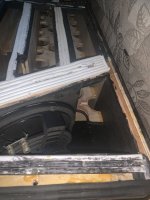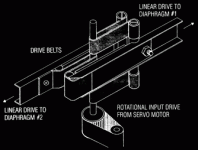I have a pair of old original VMPS Original Subwoofers - They are about 20 some years old but still work fine. I have been thinking of upgrading but then thought I have great enclosures maybe I could just upgrade the drivers and passive radiators.
I have noticed that there is very little current information on passive radiators.
Has the Passive Radiator gone out of vogue?
Is there a reason for not using them?
VMPS prided themselves on having a "musical sub" but I have heard that vented and passive radiator subs are slower than sealed and not good for music.
Anyone have any thoughts?
I have noticed that there is very little current information on passive radiators.
Has the Passive Radiator gone out of vogue?
Is there a reason for not using them?
VMPS prided themselves on having a "musical sub" but I have heard that vented and passive radiator subs are slower than sealed and not good for music.
Anyone have any thoughts?
Passive radiators are still around, but from a manufacturing standpoint they're more expensive than just using a port for a typical speaker. That's probably driving a lot of the decision for mainstream equipment.
Small sealed boxes with high power/high excursion drivers and EQ have gotten cheaper, so they're a more viable option than before also. Purists typically prefer a sealed box, but many say the group delay of ported/passive radiator designs isn't that important at very low frequencies.
In very small enclosures (soundbars, etc.) you often see passive radiators. It's difficult to fit the proper port in a small box that's tuned low, so they're sometimes the only option. You do see some used in tower speakers also, where it often seems as much about aesthetics as anything else. A bunch of identical looking drivers/passive radiators can look impressive.
I think passive radiators are a little more unstable at very low frequencies compared to ports, so in true subwoofers that could limit output in that region. That's the only significant performance downside I can think of off the top of my head for them vs. ports, but someone else may have more to say about it.
Small sealed boxes with high power/high excursion drivers and EQ have gotten cheaper, so they're a more viable option than before also. Purists typically prefer a sealed box, but many say the group delay of ported/passive radiator designs isn't that important at very low frequencies.
In very small enclosures (soundbars, etc.) you often see passive radiators. It's difficult to fit the proper port in a small box that's tuned low, so they're sometimes the only option. You do see some used in tower speakers also, where it often seems as much about aesthetics as anything else. A bunch of identical looking drivers/passive radiators can look impressive.
I think passive radiators are a little more unstable at very low frequencies compared to ports, so in true subwoofers that could limit output in that region. That's the only significant performance downside I can think of off the top of my head for them vs. ports, but someone else may have more to say about it.
Last edited:
To elaborate on mattstat's points, while a port may make "chuffing" wind noise when overdriven, a passive radiator's Xmax is actually Xmech, (mechanical limit) and will make a knocking "pup-pup" noise if driven to or beyond. The limit is not gradual.Anyone have any thoughts?
That limitation often requires double (or more) the Sd of the driver to get the required displacement from the passive radiator(s).
Vents:
Advantages: Cheaper to implement, more linear than PRs
Disadvantages: "Organ-pipe" resonances, might be difficult to fit in a small enclosure, box can't be airtight.
PRs:
Advantages: No "organ-pipe" resonances, subjectively better-sounding (see note below), enclosure can be made airtight
Disadvantages: More expensive, higher 2nd order THD than vented system, null at PR's natural resonant frequency.
The "subjectively better sounding" impression of PRs can be due to two things - the increased 2nd order HD (which can be euphonic) and, in my opinion, the much lower particle velocity (the CSA of a PR is usually much higher than a vent) that's a closer match to the particle velocity produced in front of the driver.
Advantages: Cheaper to implement, more linear than PRs
Disadvantages: "Organ-pipe" resonances, might be difficult to fit in a small enclosure, box can't be airtight.
PRs:
Advantages: No "organ-pipe" resonances, subjectively better-sounding (see note below), enclosure can be made airtight
Disadvantages: More expensive, higher 2nd order THD than vented system, null at PR's natural resonant frequency.
The "subjectively better sounding" impression of PRs can be due to two things - the increased 2nd order HD (which can be euphonic) and, in my opinion, the much lower particle velocity (the CSA of a PR is usually much higher than a vent) that's a closer match to the particle velocity produced in front of the driver.
@Brian Steele I've read Nelson Pass on 2n order harmonic H2 Harmonic generator. - My subs are extremely old - like 25 years or so and you can adjust them by adding clay to the passive radiator - I haven't done anything in a long time and I have better measurement capability than in the past so I plan to do some measurements and try and figure out what the clay is doing - The enclosure are huge and very robust - I plan on playing with dsp then in the future possibly replace the passive radiator and the main driver -- there must have been some improvement in the technology over the years
The number of available drivers and the breadth of specification has increased drastically in recent years. There is a driver for every scenario.
If your only constant is cabinet volume which offers best performance: 12" woofer + 12 passive radiator vs 2 x 12" woofers?
If your only constant is cabinet volume which offers best performance: 12" woofer + 12 passive radiator vs 2 x 12" woofers?
I'm a big PR advocate, but I must say that it only makes sense (for me) to use them to boost the sub-bass region due to all the group delay issues. Or if you're using them in a small speaker with a higher f3, I'd still tune them a little too low just to give the system a little more of a gentle roll off and therefore better group delay.
IMHO, I wouldn’t change anything but refoam the drivers or recap the amps. Those are great subs and in my mind you couldn’t make them better.
Is spacing the driver and PR important for the opposite phase they share When in motion ?
This always made me wonder in my little pea brained head
This always made me wonder in my little pea brained head
Spacing shouldn't any more important than positioning ports. Now orientation? That can make difference in how much the enclosure jumps around at high outputs. Also facing a PR down is usually a bad idea because of high mass and suspension sag.
I'm a big fan of small passive radiated boxes, and simple wedge or rectangular boxes. Seems as though we are in a sweet time for subs, for small, manufacturer's are jumping on board more and more. Thats making compatible subs to go in small air tight enclosures and sound excellent if its right.
Including myself. As far as really enjoying them goes. My smallest box is 8x8x8 inches with pr. It can/does surprise everyone in the audio rhelm with u s.
Including myself. As far as really enjoying them goes. My smallest box is 8x8x8 inches with pr. It can/does surprise everyone in the audio rhelm with u s.
Is spacing the driver and PR important for the opposite phase they share When in motion ?
I'll let you decide 😉; consider the late/great servo driven Intersonics/DSL Servo-Drive Contrabass sub with its powerful, linear, mechanically driven dual 15" drivers pumping into a 10 ft^3 dual 18" PR @ 16 Hz/500 W and try to imagine how much it would rock back n' forth if all four radiators were on one baffle.........
Correction, it should of been 3 sides by 12" not 8".
BTW if anyone is shopping for subs that shine with small footprints with and without PR Dayton has a few in the lineups. I have an older one that ran a few versions then morphed into the ultimax.then theres another. You can't miss the dayton I'm referring to the magnet dwarfs all the others. Also said to work in tight boundaries. They might still make their highest offerings in the USA. So if your like me and prefer it for piece of mind your good.
I can vouch for their sub value. It pounds in such a small box and is livable as is. But I want to push it and do a rectangular sealed box, possibly with a PR and 1.00 FT. Minus about .20 or 25 for mybraces.
The highest Dayton subs are built like trucks.
Mine started puking air through t he cheap terminal cup lol. Also a little more tuning (with rockwool) is in order.
In room sounds vg in the little wedge, with some xover only atm.
Have a look, good values for solid PR ready.
BTW if anyone is shopping for subs that shine with small footprints with and without PR Dayton has a few in the lineups. I have an older one that ran a few versions then morphed into the ultimax.then theres another. You can't miss the dayton I'm referring to the magnet dwarfs all the others. Also said to work in tight boundaries. They might still make their highest offerings in the USA. So if your like me and prefer it for piece of mind your good.
I can vouch for their sub value. It pounds in such a small box and is livable as is. But I want to push it and do a rectangular sealed box, possibly with a PR and 1.00 FT. Minus about .20 or 25 for mybraces.
The highest Dayton subs are built like trucks.
Mine started puking air through t he cheap terminal cup lol. Also a little more tuning (with rockwool) is in order.
In room sounds vg in the little wedge, with some xover only atm.
Have a look, good values for solid PR ready.
Attachments
The problem with those is that the pads on the drive arm (not shown in that illustration) aren't perfectly elastic, so there's a bump as the motor rotates through the resting point. I assembled the rotary-to-linear converters for my kit Contrabass sometime before final assembly, and I could easily feel that. There's kind of a grumbling sound from the subs, which other reviews also mention. It wouldn't be noticeable in larger rooms or when the world is exploding on a movie soundtrack, but with something like a dub bassline it's pretty obvious.Wow! Thus is crazy cool
Attachments
What model is that one? I noticed this Dayton on sale https://www.parts-express.com/Dayto...Excursion-Subwoofer-22-ohm-295-290?quantity=1I agree👍🏼
I may grab one to go with current build. Because two subs are better than one.
- Home
- Loudspeakers
- Subwoofers
- Passive Radiator Subs




